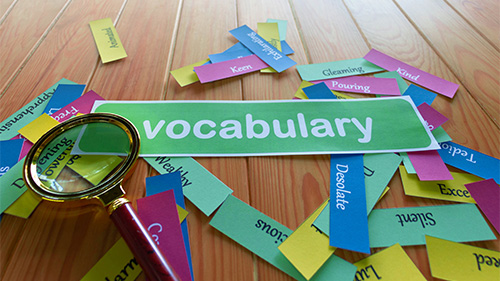Does Gatsby Really Matter? Combating Apathy in the ELA Classroom
Given that lately I am as burnt out as they come, I found myself wanting to do something unusual.
AP & Honors Mathematics
Explore Wiley titles to support both AP and Honors mathematics instruction.
Literacy Skills & Intensive Reading
Connections: Reading – Grades 6–12
Empower student success with a proven intensive reading program that develops strong reading skills in striving readers.
Drama, Speech & Debate
Basic Drama Projects 10th Edition
Build students’ confidence and competence with comprehensive, project-based theatre instruction.
Literature
Connections: Literature
Support learners as they study dynamic, relevant texts and bring the richness of diverse voices to students through literature.
Literature & Thought
Develop critical thinking, reading, and writing across literacy themes, genres, historical eras, and current events.
Language Arts
Vocabu-Lit® – Grades 6–12
Help students build word power using high-quality contemporary and classic literature, nonfiction, essays, and more.
Connections: Writing & Language
Help students develop grammar, usage, mechanics, vocabulary, spelling, and writing and editing skills.
Reading/English Language Arts
Measuring Up to the English Language Arts Standards
Incorporate standards-driven teaching strategies to complement your ELA curriculum.
English Language Learners
Measuring Up for English Language Learners
Incorporate research-based best practices for ELLs with an approach that includes a focus on language acquisition strategies.
Mathematics
Measuring Up to the Mathematics Standards
Incorporate standards-driven teaching strategies to complement your mathematics curriculum.
Foundations
Measuring Up Foundations
Help students master foundational math skills that are critical for students to find academic success.
Science
Measuring Up to the Next Generation Science Standards
Give students comprehensive NGSS coverage while targeting instruction and providing rigorous standards practice.
Assessment
Measuring Up Live
Deliver innovative assessment and practice technology designed to offer data-driven instructional support.
For a better website experience, please confirm you are in:
5 min read
 Kristian Kuhn
Oct 18, 2021 10:00:00 AM
Kristian Kuhn
Oct 18, 2021 10:00:00 AM

Back in my hometown, it was a rite of passage at the age of twelve to get a paper route. There was no status associated with it, nor did it come with a certain badge of honor – you see, back in the day kids got newspaper gigs to have deep pockets so that they could buy candy and Nintendo games and G.I. Joes.
But I was different.
I wanted to paint like Bob Ross.
So, I was saving my keep to buy an easel and brushes and his entire palette of vibrant paints.
My Saturday morning routine as a kid was to wake up early and watch cartoons until The Joy of Painting would come on. I’d scarf down a bowl of cereal and then lie out all of my supplies alongside my blank canvas and eagerly wait to see what Bob Ross had up his sleeve for the day.
I did this practice for years.
And the miracle is this—I was absolutely inept as a painter when I first began.
But I flourished over time with practice and under the guidance of a good teacher.
Some years later, I found myself as a first-year ELA teacher struggling to get my students to write effectively. No matter what I did, I just wasn’t seeing any growth in the vast majority of my student writers.
91% of secondary ELA teachers attest to having never been taught how to teach writing in their practicums, and I belonged to this number.
And then it hit me.
What if I teach writing like Bob Ross teaches painting?
Think about the simplicity and efficacy of it.
He comes on to the screen and he might say…
“Hello happy little people! Today we are going to paint a beautiful New England autumnal landscape with beautiful fall foliage, and in the center of our canvas, we are going to include a New England wood-covered bridge going over a little babbling brook.”
What is it that Bob Ross is doing to ensure that each student can learn and maximize their potential?
Does he equip his students with graphic organizers?
Does he have his students pre-draft with Venn diagrams?
Does he talk into the ether about the theory and technique of painting?
Does he unpack the directions for the task and then mill around the room receptive to field questions while his students try to figure it out on their own?
Does he sit at his desk and work a Sudoku while his students fret beneath the demands of a strict deadline?
Bob Ross does none of these things. Conversely, he walks his students through the process of creating each individual painting while providing plenty of exemplars and models all while using one simple heuristic – the wet-on-wet technique.
So, what if I were to teach writing like Bob Ross teaches painting?
What would that look like?
When I teach teachers how to teach writing, I tell them that it’s very important that they do three things:
Novice learners learn best when they are given an opportunity to emulate an expert. This is why it’s so important for composition teachers to position themselves as the expert writer in the classroom. In other words, be the Bob Ross of composition in your classroom and “paint” with your students when you provide them with a writing task.
There is fundamental difference between the “assigning” of writing and the direct “teaching” of it. When we write with our students and clearly delineate for them the steps inherit in the writing process, we are directly teaching the craft of writing.
One little known fact about Bob Ross is that he only ever used one heuristic. He called it the wet-on-wet technique. And for our students, all they need to write across the expository modes are a few templates.
Let’s imagine that we just finished a unit on Much Ado About Nothing with our sophomore class.
We had great discussions during our Socratic seminars and fishbowls. We turned over every rock and explored every single nuance. The students thoroughly know the ins and outs of this play.
So, how do you get your students to capture their thinking on paper?
First, I provide exemplars and models for my students that I write.
Second, I equip my students with a couple of templates and heuristics.
As an example, let’s imagine that we are teaching our students how to write the introductory paragraph.
Over my career, I have developed two ways to tackle introductions: the declarative and inverted thesis.
Whether a student declares or inverts depends largely upon the expository mode. But at its essence, both approaches are to be four sentences long, no more, no less – contain an academic tone while manipulating the syntax for voice, rhythm, and flow.
Left to their own devices, students will do some pretty bizarre things that leave us scratching our heads like writing fourteen sentence long introductions that don’t even contain a thesis. Or they may write a one sentence introduction that contains a literary terms dumping ground. They might be all over the place.
Students need structure and they need models.
Implicit in every well-written prompt are two questions:
These questions must be addressed in the introductory paragraph for both literary and rhetorical analysis.
Let’s get back to Much Ado About Nothing. Prior to students sitting down for the writing workshop, I write three sample introductions to demonstrate the idea that for literary analysis, the student always should invert.
Here is one example:
Love is nothing more and nothing less than a social construct. As such, it doesn’t exist. The contrived and superficial nature of the Renaissance courtiers in the play highlight the ridiculousness of the social norms one must subscribe to in order to find true “love.” Shakespeare illustrates these points through the motif of counterfeiting and the symbolic nature of taming animals.
In this inverted thesis, I first address the question: what is the authorial intent? Focusing on the main thematic components of the play until the fourth sentence, I conclude by answering the question—how does the author construct meaning. The sentence constructs are varied. The tone is academic without being overly pedantic. Well done. A perfect inverted thesis.
Here’s another example using the exact same template and following the exact same approach:
In life, it is clear that deception may give us what we want for the time being, but it will always take it away in the end. Further, deceit seems to lead to a ruinous path to happiness. Mocking the social ethos of Renaissance courtiers, Much Ado About Nothing is a stark reminder of the fact that the ploys involved in the social game of wooing are quite literally an act of nothingness. Shakespeare conveys this message through the depiction of Hero’s death and the symbolism behind the taming of wild animals.
This is yet another inverted thesis. The first three sentences directly address the authorial intent. And given the focus on the literary terms and devices in the fourth sentence, this example like the first gets to the construction of meaning in the last move.
And I’d show my students a third example just to really solidify their understanding:
Shakespeare makes it clear that the social codes pertaining to Renaissance maidenhood are absurd. Having a clear double-standard, the rules that govern a man’s “honor” are not quite the same for women. Drawing a line down the middle of traditional gender roles, the play mocks and ridicules an antiquated system that is in bad need of some serious rethinking. Shakespeare arrives at these points through the staging of Hero’s death and the prevalent war imagery throughout the piece.
And just like the wet-on-wet technique, you get another happy little inverted thesis here that first explores the question of the authorial intent and then concludes with a discussion of the construction of meaning.
Students can do this every time they write a literary analysis essay. Further, the declarative and inverted approach can be used across all of the expository modes.
After seeing three examples and unpacking them together as a class, students then tackle their own introductions. You would be surprised at just how much the Bob Ross approach demystifies the writing process for our students. Since they have good models to work from, their writing should be solid and of their best quality.
When we Bob Ross our instruction, we foster an environment whereby all of our students can grow and mature as writers. Embracing this approach levels the playing field for so many of our students. It gives them access to a discipline that far too many students historically have been denied access to.
Good writing is good thinking and good thinking is good living.
And that is the point—education as a tool for empowerment and equity.
Happy teaching and happy writing!
For a hands-on practice in how to teach composition like Bob Ross teaches painting…check out the webinar recording below!
Kristian Kuhn is currently is in his 20th year teaching English courses in Upstate New York at both the secondary and collegiate level. In addition to teaching, Kristian offers courses and seminars with the focus of teaching teachers how to teach writing. He received his graduate degrees in English and education from Brown University. In his free time, Kristian loves to spend his time out on the water paddle boarding. To learn more about his Masterclass entitled Teaching Teachers How to Teach Writing, visit his webpage here!

Given that lately I am as burnt out as they come, I found myself wanting to do something unusual.

During Pride Month, everyone expects coming out stories or rainbow flags to take over their social media profile pics–and honestly, I love those...

New York Times bestselling author Ruta Sepetys chats with Stephanie Nugent about how to use her new book Unveiling You: The Story to help your...

Teaching vocabulary—integrated into a text or isolation can be tricky when it comes to thinking of engaging ways to create meaning. We fall back on...

While the 2023 AP English Language and Composition exam represents year 4 of assessment using the analytic scoring guide and year 3 of the changes to...

Join Laura Kebart (LanguageArtsTeachers.com) for a fun walkthrough of four strategies to keep your middle school ELA students engaged all year long!

Although our middle school ELA students should have been capitalizing words like "I" since they were in early elementary school, many either just...

Most AP English teachers now find themselves well into this critical second half of the school year. With the AP exam quickly approaching in May (I...

Unlock the power of historical thinking and writing as you elevate complexity and engagement in AP History classrooms. Presented by experienced AP...

In recent months, the Taliban in the Middle East has taken over once again after American troops removed themselves. The first person I thought of...

If you’ve ever waited longer than you thought humanly possible for a complete sentence to appear during a writing assignment (only to discover...

The concept of a "Line of Reasoning" is not unfamiliar to students, but the terminology and various approaches to developing a line of reasoning may...
